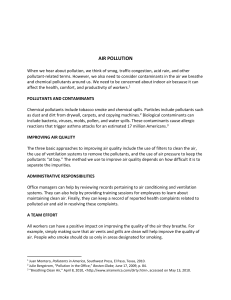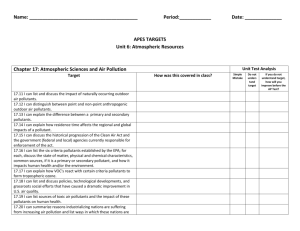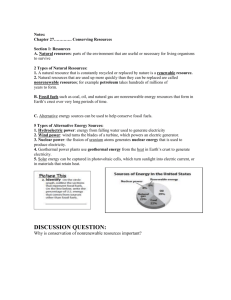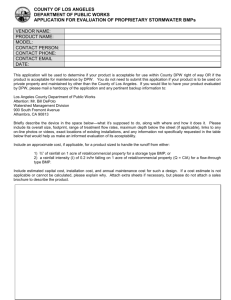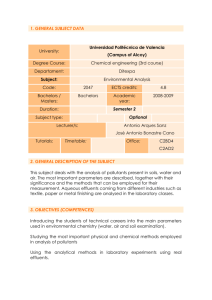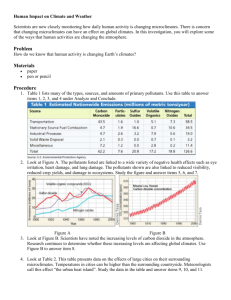`The impact of the environment on children`s health`
advertisement
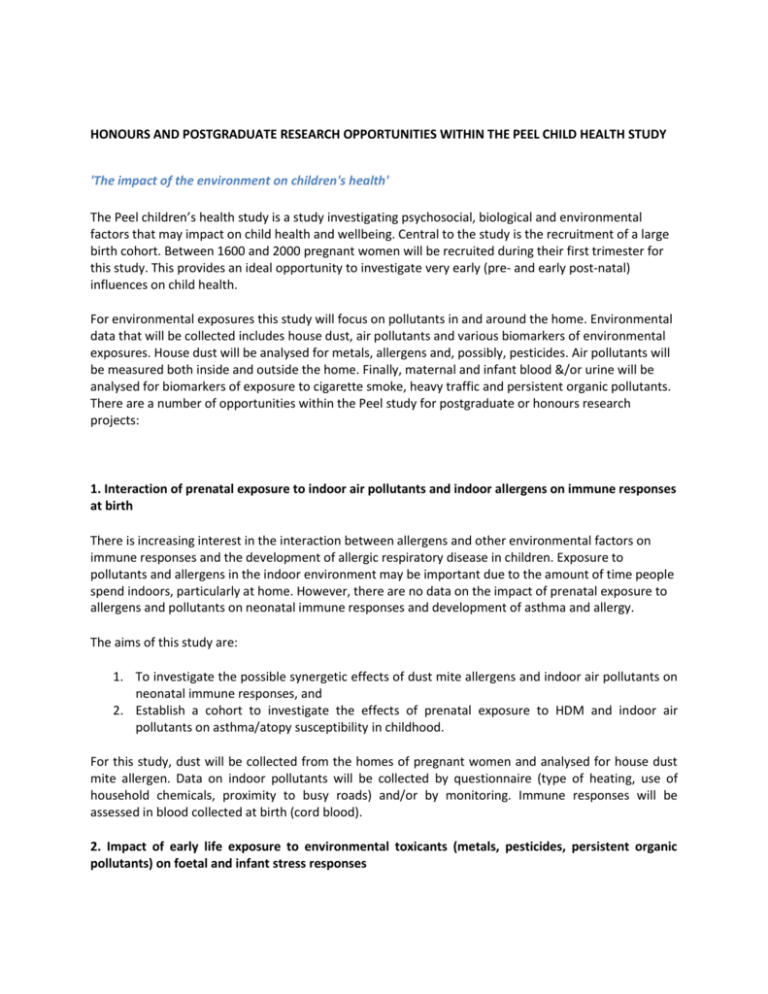
HONOURS AND POSTGRADUATE RESEARCH OPPORTUNITIES WITHIN THE PEEL CHILD HEALTH STUDY 'The impact of the environment on children's health' The Peel children’s health study is a study investigating psychosocial, biological and environmental factors that may impact on child health and wellbeing. Central to the study is the recruitment of a large birth cohort. Between 1600 and 2000 pregnant women will be recruited during their first trimester for this study. This provides an ideal opportunity to investigate very early (pre- and early post-natal) influences on child health. For environmental exposures this study will focus on pollutants in and around the home. Environmental data that will be collected includes house dust, air pollutants and various biomarkers of environmental exposures. House dust will be analysed for metals, allergens and, possibly, pesticides. Air pollutants will be measured both inside and outside the home. Finally, maternal and infant blood &/or urine will be analysed for biomarkers of exposure to cigarette smoke, heavy traffic and persistent organic pollutants. There are a number of opportunities within the Peel study for postgraduate or honours research projects: 1. Interaction of prenatal exposure to indoor air pollutants and indoor allergens on immune responses at birth There is increasing interest in the interaction between allergens and other environmental factors on immune responses and the development of allergic respiratory disease in children. Exposure to pollutants and allergens in the indoor environment may be important due to the amount of time people spend indoors, particularly at home. However, there are no data on the impact of prenatal exposure to allergens and pollutants on neonatal immune responses and development of asthma and allergy. The aims of this study are: 1. To investigate the possible synergetic effects of dust mite allergens and indoor air pollutants on neonatal immune responses, and 2. Establish a cohort to investigate the effects of prenatal exposure to HDM and indoor air pollutants on asthma/atopy susceptibility in childhood. For this study, dust will be collected from the homes of pregnant women and analysed for house dust mite allergen. Data on indoor pollutants will be collected by questionnaire (type of heating, use of household chemicals, proximity to busy roads) and/or by monitoring. Immune responses will be assessed in blood collected at birth (cord blood). 2. Impact of early life exposure to environmental toxicants (metals, pesticides, persistent organic pollutants) on foetal and infant stress responses Exposure to undesirable influences in a child's environment may modify the child's biology through the hypothalamic-pituitary-adrenal (HPA)-axis, the central mediator of the stress response. Both hyper- and hypoactivity of the HPA axis have been associated with such adverse outcomes as cardiovascular disease, behavioural disorders and mental health problems all of which show clear social gradients. As part of the Peel health study HPA activity in pregnant mothers and newborns will be assessed by salivary cortisol and blood catecholamine levels. The aim of the study is to determine the impact of environmental exposure on these measures of HPA activity. Pollutants will be measured in house dust samples (metals and/or pesticides) as well as in the urine or blood (POPs). 3. Impact of environmental pollutants on foetal growth There is evidence that environmental pollutants can impact foetal growth and birth outcomes. The most obvious example of this is maternal smoking, which has been associated with low birth weight. There are little data on the effects of other pollutants. In the Peel study, foetal growth will be assessed using ultrasound data collected at 18, 26 and 34 weeks of pregnancy. At birth, body weight and height will define the body mass index (BMI) as an index of physical development and head circumference (HCF) as an index of brain growth. Intra-uterine growth (IUGR) will be measured using existing diagnostic criteria, ultrasound Doppler scans, uterine and umbilical blood flow measures, and new measures of IUGR called proportional of optimal foetal weight (POFW) and optimal birthweight (POBW). 4. Biomarker research One of the major difficulties on environmental health research is the assessment of exposure. Exposure assessment is an evolving science and future studies need to consider methods to improve the exposure metric. One area of exposure assessment that has been developing in recent times is the use of biomarkers. The concept has been around for many years, e.g. the use of cotinine as a marker of cigarette smoke exposure. With advances in analytical techniques it is now possible to measure very low concentrations of environmental chemicals or chemical by-products in human tissue and biomarkers of both exposure and of effect are increasingly being used for environmental health research involving air pollutants. However, although biomonitoring offers exciting opportunities, there is still a limited understanding of the relationship between environmental concentrations and biomarkers, particularly for low level exposures that occur in homes. In the Peel study we will be collecting biological fluid (blood and urine) from mothers and infants and this opens the opportunity for research on the relationships between various biomarkers and concentrations of the relevant pollutants in the environment. The PCHS is funded by the Australian Research Council, The National Health and Medical Research Council of Australia and the Asthma Foundation of Western Australia. For more information please contact: Dr Phil Stumbles School of Veterinary & Biomedical Sciences Tel: 9360 6201 Email: p.stumbles@murdoch.edu.au 5. Honours Projects in the Peel Child Health Study The Peel Child Health Studies (PCHS) is an on-going human birth cohort study funded by the Australian Research Council and the National Health and Medical Research Council of Australia based in the Peel Region surrounding Mandurah in Western Australia. We have been collecting a large range of biological, psychosocial and community parameters to allow us to examine the impact of the maternal physical and biological environment on child development. We have now collected a range of samples that will allow us to associate a number of maternal exposures at early and late stages of gestation, including physical (inorganic metals, bacterial endotoxins, allergens) and biological (cortisol, vitamin D) with fetal and neonatal development including in utero fetal growth, cord blood cellular responses and measurements of immune function. Honours projects are available for students with a suitable background and academic record to investigate associations these maternal exposures and the biological “health” of the child with a focus on immune function and development. The student will gain a range of skills in analysis of human data sets and biological measurements. Projects can be designed, to some extent, based on the background and interest of the student. For more information contact: Dr Phil Stumbles School of Veterinary & Biomedical Sciences Tel: 9360 6201 Email: p.stumbles@murdoch.edu.au

